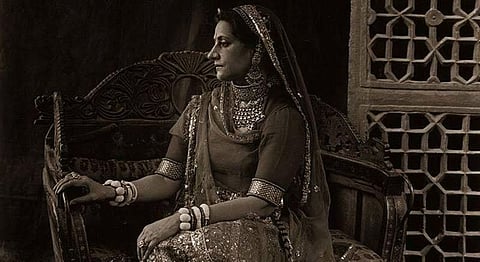
- HOMEGROWN WORLD
- #HGCREATORS
- #HGEXPLORE
- #HGVOICES
- #HGSHOP
- CAREERS
- ABOUT US
- CONTACT US

Every once in awhile at an Indian wedding there will be that one relative who will ask you to pull your dupatta or pallu a little higher because your midriff decided to say hello to the guests, or take your blouse’s plunging neckline as a good enough reason to give you a talk on how it’s not sanskari (appropriate) to wear clothes that reveal so much skin. Well, we have some news for the self-appointed Aunties of the ‘maan maryada bachao’ campaign; the Indian sari blouse isn’t all that desi as you think it is.
In sculptures from the Maurya and Sunga periods (about 300 BC), men and women wore rectangular pieces of fabric, on the lower part of the body and one on the upper part. Little else. The one constant feature of the erotic sculptures of the Khajuraho Temple (900-1050 BC) in Madhya Pradesh, is the way the women’s breasts are depicted; defying gravity with their size and either bare or bursting from whatever is left of their blouse’s seams. From this sculpture in the Gupta period, going topless seems perfectly acceptable for women. Though the rise of the Mughals in India was responsible for certain changes in Indian women’s attire like covering the head and the breasts — the modern Indian blouse was still far behind.
In Bengal, during the Victorian era, most women did not wear blouses under their saris - they wore it bare-breasted. In some parts of India covering of the breasts had more to do with caste than propriety. So who brought the blouse; the imperative paraphernalia of the sari to the Indian shores?
According to this report by the BBC, It was Jnanadanandini Debi, the wife of Satyendranath Tagore, brother of the famous Bengali poet Rabindranath Tagore who popularised blouses, jackets, chemises and the modern style of the sari in India. She reportedly did so after being refused entry to clubs under the Raj for wearing the sari fabric over her bare breasts. Shirts, sweaters and high necked Victorian blouses, much like today’s boho-fashion trends, came to be worn under the sari as part of high fashion.
The blouse that is probably Britain’s longest export to India has over the centuries gained such great indigenous appeal that it is considered part of tradition itself. While it’s interesting to see brands like Raw Mango bring the anti-fit blouse that attempts to make the sari more wearable, it tends to bear more resemblance to its Victorian counterpart than the Indian choli. Also rather ironic — collections like ‘Enter India’ by haute couture designer Elie Saab have garments like an Edwardian dress with a sari like stole which claim to be inspired by India.
While the blouse did liberate white women from the tight corsets in Europe it imposed its standard of decency and public decorum on the Indian population who had probably never considered breasts as titillating before being asked to cover it. In a country like ours where from time to time so called nationalists decide to define the integrity of a woman by her compliance to tradition, the story of the origin of the blouse shows us just how misguided notions of tradition and culture can be!
If you enjoyed reading this article you might also like:
